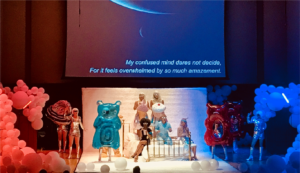Makerspace Course List
Makerspace Course List
Click on a course number below to read more about how UNC course instructors are incorporating design, making, and the makerspaces into their curricula.
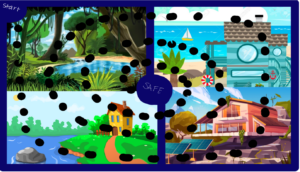 Faculty: Rachel Willis, American Studies
Faculty: Rachel Willis, American Studies
Rising Waters, AMST 460, is an APPLES service-learning seminar focusing on water threats from climate change to port cities, low-lying coastal areas, and land along rivers. Sea-level rise, extreme weather, and inadequate infrastructure all contribute. Students in AMST 460 collaborate on board games, including Climatopia, in which the goal is to build more resilient communities.
Pictured: An early visual prototype of the game board for Climatopia.
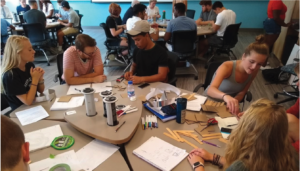 Faculty: Glenn Walters, Applied Physical Sciences; Rich Goldberg, Applied Physical Sciences
Faculty: Glenn Walters, Applied Physical Sciences; Rich Goldberg, Applied Physical Sciences
Design thinking is a popular buzz term in this age of Kickstarter, instant turnaround, and short time-to-market. But what is design thinking really all about? Students in APPL 110 dissect the design process by brainstorming, designing, and making dozens of artifacts using the BeAM makerspaces. In the process, students discover their personal strategies for moving through creative roadblocks.
Pictured: Students in an APPL 110 class participate in a design thinking exercise.
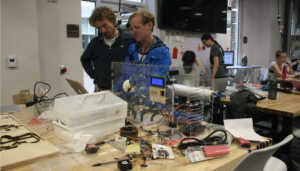 Faculty: Rich Goldberg, Applied Physical Sciences
Faculty: Rich Goldberg, Applied Physical Sciences
Do you have an entrepreneurial idea that you want to prototype? Do you want to experience the design and making process? Turn your entrepreneurial ideas into reality, using the BeAM makerspaces to create functional, physical versions of your user-centered designs. Students in APPL 412 discover that entrepreneurial ideas can emerge from discussions with their campus, local, and global communities.
Pictured: An APPL 412 student consulting on the design of a portable shoe dryer.
 Faculty: Lien Truong, Art and Art History
Faculty: Lien Truong, Art and Art History
Narrative paintings have mirrored social and scientific advancements, such as Thomas Eakins’ medical narrative paintings The Gross Clinic, 1875, and The Agnew Clinic, 1889. Students in ARTS 222 engage in the culturally rich practice of creating a narrative painting, and integrate BeAM makerspace technology during their creative process to craft a painting through their own personal lens.
Pictured: A narrative painting created by ARTS 222 student Rebecca Nguyen.
Faculty: Beth Grabowski, Art and Art History
Faculty: Roxana Perez-Mendez, Art and Art History
Faculty: Roxana Perez-Mendez, Art and Art History
Faculty: Gesche Wuerfel, Art and Art History
Faculty: Beth Grabowski, Art and Art History
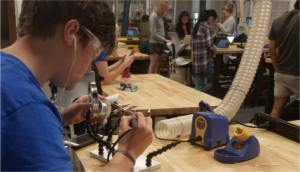 Faculty: Maggie Cao, Art and Art History
Faculty: Maggie Cao, Art and Art History
Clay, wood, cloth, glass, steel, and plastic. We use these materials every day, but rarely do we think about their properties and histories. How did the race to produce Asian porcelain in the 18-century West impact globalization? How will 3D printing expand the uses of plastics in realms from fashion to weaponry? Students in ARTH 201 explore the impact of materials on art, culture, and science throughout history.
Pictured: An ARTH 201 student solders a metal sculpture in the BeAM makerspace.
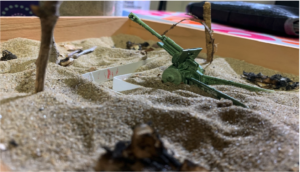 Faculty: Claudia Yaghoobi, Asian and Middle Eastern Studies
Faculty: Claudia Yaghoobi, Asian and Middle Eastern Studies
Wars and conflicts, particularly Iran-Iraq, U.S.-Iraq, and U.S.-Afghanistan wars, are portrayed extensively in literature, film, and photography. What is impact of war on the human psyche? Students in ASIA 069/PWAD 069 interpret the writings of American war veterans and Middle East authors to discuss the phenomenon of war, reflecting on these works to create a narrative object-oriented exhibit.
Pictured: An exhibition on themes of war, created by an ASIA/PWAD student.
 Faculty: Laura Miller, Biology
Faculty: Laura Miller, Biology
The natural world is replete with examples of animals and plants whose shape influences flow to their benefit. For example, the shape of a maple seed generates lift to allow for farther dispersal. A falcon’s form during a dive reduces drag and allows it to reach greater speeds. Students in BIOL 064 design their own physical modeling project and create a prototype using the BeAM makerspaces.
Pictured: A student in BIOL 064 models the flow of liquids around a 3D printed alligator.
Faculty: Alan Jones, Biology
 Faculty: Jennifer Coble, Biology
Faculty: Jennifer Coble, Biology
This course, designed for future high school science teachers, challenges them to design student-centered, hands-on lessons for a topic in the high school biology curriculum. Since much of that curriculum focuses on abstract biochemical and cellular topics, students in BIOL 410 create models in the BeAM makerspaces that allow learners to more easily conceptualize abstract topics.
Pictured: An educational tool for genetics, made by a BIOL 410 student with the laser cutter.
Faculty: Lorraine Cramer, Microbiology and Immunology
Faculty: Kenny Donnelly, Biomedical Engineering
Faculty: Kenny Donnelly, Biomedical Engineering
Faculty: Jim Kitchen, Business
Faculty: Christopher Mumford, Business
 Faculty: Brian Hogan, Chemistry
Faculty: Brian Hogan, ChemistryMacromolecular Structure and Metabolism is an upper-level chemistry course required for all B.S. chemistry (biochemistry track) majors. Students in CHEM 431 analyze current primary literature articles related to macromolecular structure and metabolism to develop an experimental framework for analysis, synthesis, and evaluation of protein structure-function relationships.
Pictured: A 3D printed protein model, similar to those created by CHEM 431 students.
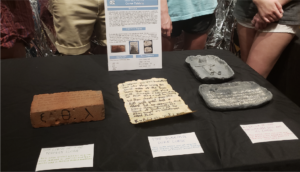 Faculty: Suzanne Lye, Classics
Faculty: Suzanne Lye, Classics
Bindings and curses, love charms and healing potions, amulets and talismans – from simple spells to complex group rituals, ancient societies made use of both magic and religion to try to influence the world around them. Students in CLAS 059 create remixed replicas of ancient objects as a way to investigate the materials and usability of objects related to ancient religious and magical practices.
Pictured: A collection of ‘curse tablets’ created by a CLAS 059 student group.
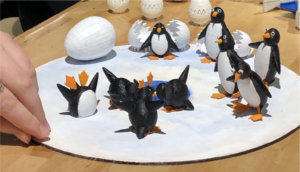 Faculty: Bill Brown, Communication; Sabine Gruffat, Art and Art History
Faculty: Bill Brown, Communication; Sabine Gruffat, Art and Art History
Though we generally think of movies as the result of the work of screenwriters, cinematographers, actors, and directors, movies are also the product of a range of technological innovations. Students in COMM 690/ARTS 490 design and fabricate cameras, lenses, film strips, and movie projectors using the BeAM makerspaces, applying emerging technologies to traditional movie making methods.
Pictured: A COMM/ARTS student uses 3D printed and laser cut pieces to create a 3D zoetrope.
What does it mean to be an educated person? What function do schools serve? Students in EDUC 065 contemplate their personal experiences with schooling before university, and deconstruct what they know about education as a result of these experiences. Using the BeAM makerspaces, students engineer a new representative vision for schooling and discuss changing the future of education.
Pictured: TBD
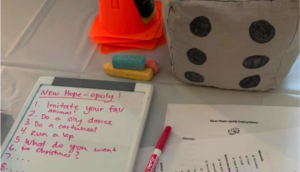 Faculty: Kristin Papoi, School of Education
Faculty: Kristin Papoi, School of Education
Whether or not you plan to pursue a career in education, each person has some connection with schools—either as a former student, parent or caregiver, friend, neighbor, or engaged community member. Students in EDUC 615 use multimodal expression to engage communities, create connected learning communities, and become transformative leaders in the American education system.
Pictured: An educational game made by students in EDUC 615 for a middle school community.
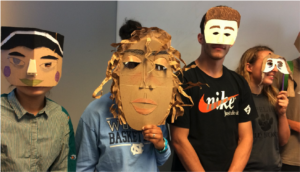
Faculty: Marianne Gingher, English and Comparative Literature
Here’s an academic alternative to running away and joining a circus: Writing for the Puppet Stage. Students in ENGL 307 engage in the puppetry arts as an expression of literary craft, and immerse themselves in writing, designing, and producing a theatrical project from initial concept to physical execution. Use of the makerspace is vital as students explore innovative techniques for puppetcraft.
Pictured: Students in ENGL 307 show off the character masks they designed and made.
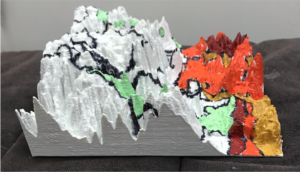 Faculty: Megan Plenge, Geology
Faculty: Megan Plenge, Geology
Geology is not just the study of rocks – it is the study of the Earth as a whole, and the complex processes that shape and change it throughout time. Students in GEOL 101L learn the fundamentals of geology: making observations of the natural world, using observations and inferences to formulate a scientific question, developing a testable hypothesis that answers that question, and testing the hypothesis.
Picture: An exaggerated topographic model of Chapel Hill, used by GEOL 101L students to predict flooding.
 Faculty: Aaron Moody, Geography
Faculty: Aaron Moody, Geography
A map presents a portal to a new world, or to new ways of understanding the worlds we think we know. Beyond their communicative power and value for navigation, maps serve as tools of political or economic control, and, when read carefully, expose the underlying social dynamics of power that shape our world. Students in GEOG 115 complete map-making projects to learn how to design, create, and critique maps.
Pictured: GEOG 115 students gather in the makerspace to design and create laser-cut maps
[/toggle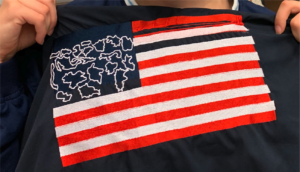 Faculty: Gosia Lee, Romance Studies; Susan Harbage Page, Women’s and Gender Studies; Gabriela Valdivia, Geography
Faculty: Gosia Lee, Romance Studies; Susan Harbage Page, Women’s and Gender Studies; Gabriela Valdivia, Geography
This Ideas, Information, and Inquire (III) course is taught by a visual artist, a Spanish teacher, and a geographer. The course covers topics such as border-crossings, well-being, and socio-environmental justice through Spanish language-based films and artwork. Students in IDST 117 engage in both individual and collaborative assignments that involve performance, creative design, and fabrication.
Pictured: An IDST 117 student shows off their project – an embroidered jacket.
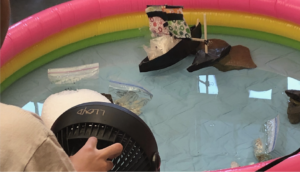 Faculty: Carol Arnosti, Marine Science
Faculty: Carol Arnosti, Marine Science
What explains the “pull of the poles”? What motivated early explorers to undergo great hardships to investigate the Arctic and Antarctic? Students in MASC 053 connect the design and making process to the experiences of early polar explorers as well as modern oceanographers, who often have to improvise and fix or build or create things on the spot, with materials at hand, in order to solve specific problems.
Pictured: Students in MASC 053 test the arctic exploration vessels they designed and built
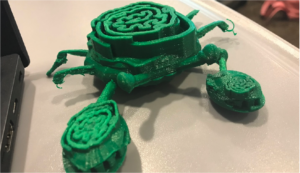 Faculty: Alecia Septer, Marine Science
Faculty: Alecia Septer, Marine Science
Marine environments contain a rich diversity of organisms, from single-celled phytoplankton to sea birds and marine mammals. Each organism uses special physiological adaptations to live in their marine habitat, whether that’s the deep sea or our own Carolina coast. Students in MASC 442/BIOL 457 use their new knowledge about functional biology, ecology, and biodiversity to describe a newly discovered organism.
Pictured: A 3D printed crab with unique adaptations designed by a MASC/BIOL student.
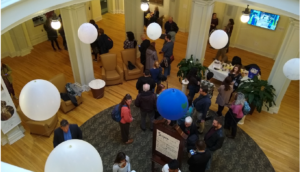 Faculty: Anne MacNeil, Music
Faculty: Anne MacNeil, Music
Students in MUSC 063 experiment with tools and techniques for understanding multimedia, staged musical works like opera, musical theater, and film. The goal of the seminar is to develop students’ analytical skills in verbal and nonverbal media and to encourage their visualization of the potential and implications of artistic forms and structures.
Pictured: Students from MUSC 063 gather in Hill Hall to discuss their work on the opera Scipio.
 Faculty: Stefan Jeglinski, Physics; Jennifer Weinberg-Wolf, Physics
Faculty: Stefan Jeglinski, Physics; Jennifer Weinberg-Wolf, Physics
Familiar, everyday mechanisms are a great way to see physics in action – including mechanics (e.g. cars, carnival rides), thermodynamics (e.g. ovens, air conditioners), electricity and magnetism (e.g., microwaves, radio), and light (e.g., lasers, light bulbs). Students in PHYS 100 design and construct a time-keeping device in the BeAM makerspaces to learn about the critical impact of clocks on the advancement of science.
Pictured: A PHYS 100 student assembles their clock escapement project in the makerspace.
 Faculty: Viji Sathy, Psychology and Neuroscience
Faculty: Viji Sathy, Psychology and Neuroscience
How do you persuade others with numbers? What are the common biases and fallacies that we have in understanding numbers and statistics? There are many ways that data are reported to the public in our everyday lives, through advertising and media as well as scientific journal articles. Students in PSYC 053 use the design and making process to make abstract topics about numbers more concrete.
Pictured: Students in PSYC 053 present a prototype of a interactive statistical model.
